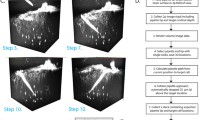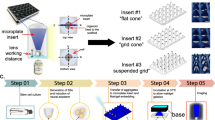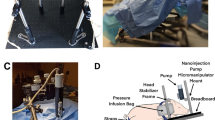Abstract
Optical imaging of wholemount tissue samples provides greater understanding of structure–function relationships as the architecture of these specimens is generally well preserved. However, difficulties arise when attempting to stitch together images of multiple regions of larger, oddly shaped specimens. These difficulties include (1) maintaining consistent signal-to-noise ratios when the overlying sample surface is uneven, (2) ensuring sample viability when live samples are required, and (3) stabilizing the specimen in a fixed position in a flowing medium without distorting the tissue sample. To address these problems, we designed a simple and cost-efficient device that can be 3D-printed and machined. The design for the device, named the Platform for Planar Imaging of Curved Surfaces (PICS), consists of a sample holder, or “cap” with gaps for fluid flow and a depression for securing the sample in a fixed position without glue or pins, a basket with two arms that move along an external radius to rotate the sample around a central axis, and a customizable platform designed to fit on a commercially available temperature control system for slice electrophysiology. We tested the system using wholemounts of the murine subventricular zone (SVZ), which has a high degree of curvature, to assess sample viability and image quality through cell movement for over an hour for each sample. Using the PICS system, tissues remained viable throughout the imaging sessions, there were no noticeable decreases in the image SNR across an imaging plane, and there was no noticeable displacement of the specimen due to fluid flow.






Similar content being viewed by others
References
Chang EH, Adorjan I, Mundim MV, Sun B, Dizon ML, V (2016) Traumatic brain injury activation of the adult subventricular zone neurogenic niche. Front Neurosci. https://doi.org/10.3389/fnins.2016.00332
Cheong WF, Prahl SaS, Welch aJA (1990) A review of the optical properties of biological tissues. IEEE J Quantum Electron. https://doi.org/10.1109/3.64354
Comte I, Kim Y, Young CC, Harg JM, Van Der Hockberger P, Bolam PJ, Poirier F, Szele FG (2011) Galectin-3 maintains cell motility from the subventricular zone to the olfactory bulb. J Cell Sci https://doi.org/10.1242/jcs.079954
Cyran CC, Paprottka PM, Eisenblätter M, Clevert DA, Rist C, Nikolaou K, Lauber K, Wenz F, Hausmann D, Reiser MF, Belka C, Niyazi M (2014) Visualization, imaging and new preclinical diagnostics in radiation oncology. Radiat Oncol 9:3. https://doi.org/10.1186/1748-717X-9-3
Darnell DK, Stanislaw S, Kaur S, Antin PB (2010) Whole mount in situ hybridization detection of mRNAs using short LNA containing DNA oligonucleotide probes. RNA 16:632–637. https://doi.org/10.1261/rna.1775610
Fiorelli R, Azim K, Fischer B, Raineteau O (2015) Adding a spatial dimension to postnatal ventricular-subventricular zone neurogenesis Development. https://doi.org/10.1242/dev.119966
Goings GE, Sahni V, Szele FG (2004) Migration patterns of subventricular zone cells in adult mice change after cerebral cortex injury. Brain Res 996:213–226. https://doi.org/10.1016/J.BRAINRES.2003.10.034
Graydon ML, Giorgi PP (1984) Topography of the retinal ganglion cell layer of Xenopus. J Anat 139(Pt 1):145–157
Hagl CI, Wink E, Scherf S, Heumüller-Klug S, Hausott B, Schäfer K-H (2013) FGF2 deficit during development leads to specific neuronal cell loss in the enteric nervous system. Histochem Cell Biol 139:47–57. https://doi.org/10.1007/s00418-012-1023-3
Lennington JB, Yang Z, Conover JC (2003) Neural stem cells the regulation of adult neurogenesis. Reprod Biol Endocrinol 1:99. https://doi.org/10.1186/1477-7827-1-99
Martinez-Molina N, Kim Y, Hockberger P, Szele FG (2011) Rostral migratory stream neuroblasts turn and change directions in stereotypic patterns. Cell Adhes Migr 5:83–95. https://doi.org/10.4161/cam.5.1.13788
Mirzadeh Z, Doetsch F, Sawamoto K, Wichterle H, Alvarez-buylla A (2010a) The subventricular zone en-face: wholemount staining and ependymal flow JoVE. https://doi.org/10.3791/1938
Mirzadeh Z, Han Y-G, Soriano-Navarro M, García-Verdugo JM, Alvarez-Buylla A (2010b) Cilia organize ependymal planar polarity. J Neurosci 30:2600–2610. https://doi.org/10.1523/JNEUROSCI.3744-09.2010
Nagasawa H, Yanai R (1977) Mammary growth and function and pituitary prolactin secretion in female nude mice. Eur J Endocrinol 86:794–802. https://doi.org/10.1530/acta.0.0860794
Nam SC, Kim Y, Dryanovski D, Walker A, Goings G, Woolfrey K, Kang SS, Chu C, Chenn A, Erdelyi F, Szabo G, Hockberger P, Szele FG (2007) Dynamic features of postnatal subventricular zone cell motility: a two-photon time-lapse study. J Comp Neurol 505:190–208. https://doi.org/10.1002/cne
Parra SG, Chia TH, Zinter JP, Levene MJ (2010) Multiphoton microscopy of cleared mouse organs. J Biomed Opt 15:036017. https://doi.org/10.1117/1.3454391
Platel J, Heintz T, Young S, Gordon V (2008) Tonic activation of GLU K5 kainate receptors decreases neuroblast migration in whole-mounts of the subventricular zone J Physiol Banner 16, 3783–3793. https://doi.org/10.1113/jphysiol.2008.155879
Preibisch S, Saalfeld S, Tomancak P (2009) Globally optimal stitching of tiled 3D microscopic image acquisitions. Bioinformatics 25:1463–1465. https://doi.org/10.1093/bioinformatics/btp184
Rosewell IR, Giangreco A (2012) Murine aggregation chimeras and wholemount imaging in airway stem cell biology. Humana Press, Totowa, pp 263–274. https://doi.org/10.1007/978-1-61779-980-8_20
Sasaki H, Hogan BL (1993) Differential expression of multiple fork head related genes during gastrulation and axial pattern formation in the mouse embryo. Development 118:47–59
Shen Q, Wang Y, Kokovay E, Lin G, Chuang S, Goderie SK, Roysam B, Temple S (2008) Article adult SVZ stem cells lie in a vascular niche: a quantitative analysis of niche cell–cell interactions. Cell Stem Cell https://doi.org/10.1016/j.stem.2008.07.026
Strien ME, Van Berge SA, Van Den Hol EM (2011) Migrating neuroblasts in the adult human brain: a stream reduced to a trickle. Nat Publ Gr 21:1523–1525. https://doi.org/10.1038/cr.2011.101
Thévenaz P, Unser M (2007) User-friendly semiautomated assembly of accurate image mosaics in microscopy. Microsc Res Tech 70:135–146. https://doi.org/10.1002/jemt.20393
Udan RS, Piazza VG, Hsu C-W, Hadjantonakis A-K, Dickinson ME (2014) Quantitative imaging of cell dynamics in mouse embryos using light-sheet microscopy. Development 141:4406–4414. https://doi.org/10.1242/dev.111021
Ullmann JFP, Moore BA, Temple SE, Fernández-Juricic E, Collin SP (2012) The retinal wholemount technique: a window to understanding the brain and behaviour. Brain Behav Evol 79:26–44. https://doi.org/10.1159/000332802
Wang DD, Krueger DD, Bordey A (2003) GABA depolarizes neuronal progenitors of the postnatal subventricular zone via GABA A receptor activation J Physiol. https://doi.org/10.1113/jphysiol.2003.042572
Wang C, Liu F, Liu Y, Zhao C, You Y, Wang L, Zhang J, Wei B (2011) Identification and characterization of neuroblasts in the subventricular zone and rostral migratory stream of the adult human brain. Nat Publ Gr 21:1534–1550. https://doi.org/10.1038/cr.2011.83
Young CC, Brooks KJ, Buchan AM, Szele FG (2011) Cellular and molecular determinants of stroke-induced changes in subventricular zone cell migration. Antioxid Redox Signal 14(10):1877–1888. https://doi.org/10.1089/ars.2010.3435
Young CC, Harg JM, Van Der Lewis NJ, Brooks KJ, Buchan AM, Szele FG (2013) Ependymal ciliary dysfunction and reactive astrocytosis in a reorganized subventricular zone after stroke Cereb Cortex. https://doi.org/10.1093/cercor/bhs049
Zhou B, Pu WT (2011) Epicardial epithelial-to-mesenchymal transition in injured heart. J Cell Mol Med 15:2781–2783
Acknowledgements
We would like to thank Dr. Francis Szele, Oxford University, UK, for inspiring us to create this device and for the use of his Bioptechs TC3 warming system to test the device. Graduate support was provided by a National Institutes of Health grant R21NS090131 (BSK) and a Louisiana Board of Regents Graduate Fellowship (JLS). Funding was also provided by the Edmondson/Crump Endowed Professorship, Louisiana Tech University (TAM).
Author information
Authors and Affiliations
Corresponding author
Ethics declarations
Conflict of interest
The authors declare that they have no conflict of interest.
Statement on the welfare of animals
All applicable international, national, and/or institutional guidelines for the care and use of animals were followed. All procedures performed in studies involving animals were in accordance with the ethical standards of the Louisiana Tech University Institution Care and Use Committee. This article does not contain any studies with human participants performed by any of the authors.
Additional information
Publisher’s Note
Springer Nature remains neutral with regard to jurisdictional claims in published maps and institutional affiliations.
Electronic supplementary material
Below is the link to the electronic supplementary material.
Rights and permissions
About this article
Cite this article
Scoggin, J.L., Kemp, B.S., Rivera, D.A. et al. PICS: a platform for planar imaging of curved surfaces of brain and other tissue. Brain Struct Funct 224, 1947–1956 (2019). https://doi.org/10.1007/s00429-019-01861-5
Received:
Accepted:
Published:
Issue Date:
DOI: https://doi.org/10.1007/s00429-019-01861-5




